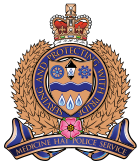
The Royal Canadian Mounted Police, colloquially known as the Mounties, are the federal and national police service of Canada, providing law enforcement at the federal level. The RCMP also provide provincial policing in eight of Canada's provinces and local policing on a contract basis in the three territories and more than 150 municipalities, 600 Indigenous communities, and three international airports. The RCMP do not provide active provincial or municipal policing in Ontario or Quebec. However, all members of the RCMP have jurisdiction as a peace officer in all provinces and territories of Canada. Despite the name, the Royal Canadian Mounted Police are no longer an actual mounted police service, with horses only being used at ceremonial events.
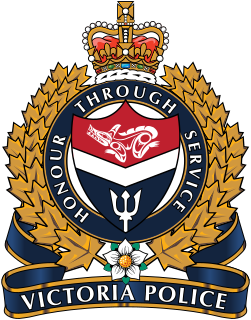
The Victoria Police Department (VicPD) is the municipal police force for the City of Victoria and the Township of Esquimalt, British Columbia, Canada. It is the oldest municipal police department in Canada west of the Great Lakes, the first Canadian law enforcement agency to deploy tasers and VicPD created the first digital forensic unit in the country. They are also one of the few police departments in Canada to use the G36 rifle.
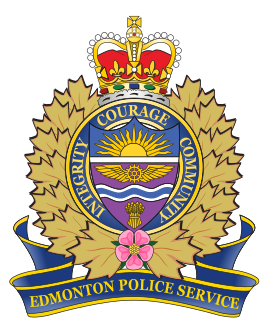
The Edmonton Police Service (EPS) is the municipal police force for the City of Edmonton, Alberta, Canada. The current chief of the EPS is Dale McFee.

Calgary Police Service (CPS) is the municipal police service of the City of Calgary, Alberta, Canada. It is the largest municipal police service in Alberta and third largest municipal force in Canada behind Toronto Police Service and Montreal Police Service.

The Canadian Pacific Police Service (CPPS) is a private railroad police force enforcing safety and policing along Canadian Pacific Railway properties and rail lines in Canada and the United States, including limited sections of the Milton line of GO Transit in the Greater Toronto Area.

Law enforcement in Canada consists of public-sector police forces that are associated with and commissioned to the three levels of government: municipal, provincial, and federal. In addition, many First Nations reserves have their own police forces established through agreements between the governing native band, province and the federal government. Most urban areas have been given the authority by the provinces to maintain their own police forces. Seven of Canada's provinces and all three territories, in turn, contract out their provincial or territorial law-enforcement responsibilities to the Royal Canadian Mounted Police, the national police force, which is commissioned to the federal level of government; the other three maintain provincial police forces, although one also partially contracts out to the RCMP. The Canada Border Services Agency (CBSA) is the second largest law enforcement agency in Canada. The CBSA facilitates the flow of legitimate travellers and trade. The agency also enforces more than 90 acts and regulations. Since December 2003, the CBSA has been an integral part of the Public Safety Portfolio. The president of the CBSA reports directly to the Minister of Public Safety Canada and controls and manages all matters relating to the agency

The British Columbia Provincial Police (BCPP) was the provincial police service of British Columbia, Canada, between 1858 and 1950.

The Central Saanich Police Service is the police force for the district municipality of Central Saanich, British Columbia. Currently headed by Chief Constable Ian Lawson with 28 constables, five of whom are seconded to Combined Forces Special Enforcement Unit (CFSEU), regional crime unit, IRSU and the National Weapons Enforcement Support Team

The Lethbridge Police Service, formerly known as the Lethbridge Regional Police Service, was established 1905, and serves the city of Lethbridge, a community in southern Alberta of approximately 101,482 in its 2019 municipal census.
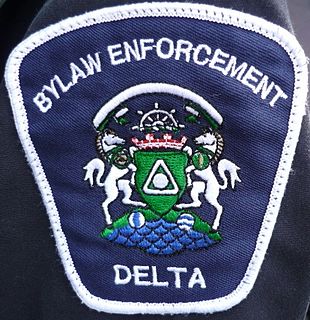
A bylaw enforcement officer is a law enforcement employee of a municipality, county or regional district, charged with the enforcement of bylaws, rules, laws, codes or regulations enacted by local governments. Bylaw enforcement officers are often out in the community responding to complaints from the public. They often work closely with local police, as well as provincial and federal authorities.

The Alberta Sheriffs Branch is a provincial law enforcement agency overseen by the Ministry of Justice and Solicitor General of the province of Alberta, Canada. Under the authority of the Peace Officer Act, Alberta Sheriffs are provincial peace officers with jurisdiction over the province of Alberta. The Premier of Alberta has the authority to grant emergency police powers to all Alberta Sheriffs in the case of any major emergencies that occur within the province. The Alberta Sheriffs Branch is the largest sheriff service in Canada.

The Alberta Provincial Police (APP) was the provincial police service for the province of Alberta, Canada from 1917 to 1932. The APP was formed as a result of the Royal Northwest Mounted Police leaving the prairie provinces during the First World War due to a lack of sufficient resources in light of its increased responsibilities for national security and reluctance to again enforce Prohibition law recently put into effect by the Alberta government after its experience doing so during territorial times. The NWMP was replaced by the newly created Alberta Provincial Police on March 1, 1917, which remained responsible for provincial policing until 1932, when it was eliminated as a cost-cutting measure during the Great Depression. The APP was known for its tumultuous beginning, battles against rum-runners and bootleggers during prohibition in Canada and the United States, as well as its remarkable efficiency and professionalism which endeared to the force to Albertans.
A special constable or special police constable is generally an auxiliary or part-time law enforcement officer.
The Kingston Police is the municipal police force for the city of Kingston, Ontario. It was established by the Common Council of Kingston on December 20, 1841, to control the lawlessness happening in the Province of Canada's capital of 8,500 inhabitants.
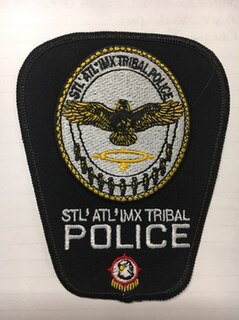
The Stlʼatlʼimx Tribal Police Service (STPS) is the police force for St'at'imc aboriginal peoples of British Columbia. The STPS is the only aboriginal police service in British Columbia. Their officers are appointed as designated provincial constables, and have full police powers on and off-duty throughout the province. They are based in Lillooet and Mount Currie.
Alberta Law Enforcement Response Team (ALERT) is an umbrella government agency uniting efforts by multiple Canadian law enforcement organizations. Known by the acronym ALERT, the agency was established in 2006. Its campaigns on behalf of the people of Alberta, as well as Canadians generally, include fighting gang activity, working against drug trafficking, and confronting domestic violence. ALERT currently includes seconded members from:
The Independent Investigation Unit is the civilian oversight agency in Manitoba, Canada responsible for the investigation of incidents resulted in serious injury or death to any person. IIU has jurisdiction over all municipal police officers, First Nations police officers and Royal Canadian Mounted Police "D" Division officers, for all complaints on or off duty related.
The police in Canada's ranks differ according to the different police forces and depend on different laws at the federal, provincial, and municipal levels.
